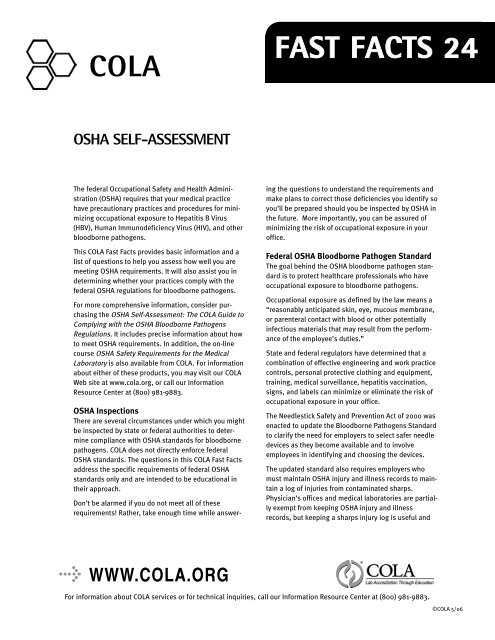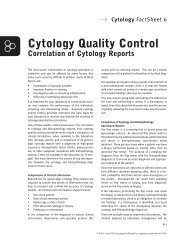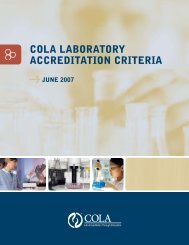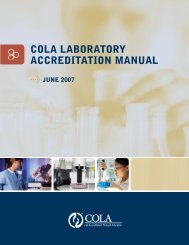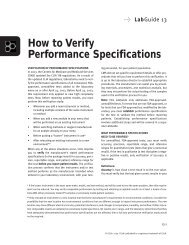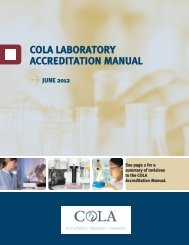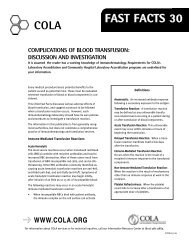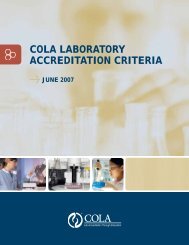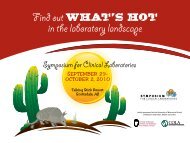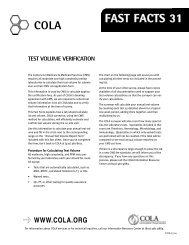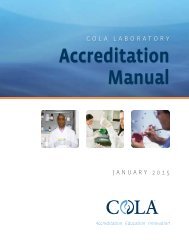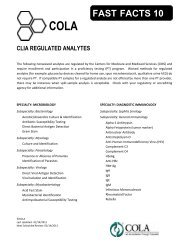OSHA Checklist - COLA
OSHA Checklist - COLA
OSHA Checklist - COLA
- No tags were found...
Create successful ePaper yourself
Turn your PDF publications into a flip-book with our unique Google optimized e-Paper software.
<strong>COLA</strong>FAST FACTS 241 of 3<strong>OSHA</strong> SELF-ASSESSMENTThe federal Occupational Safety and Health Administration(<strong>OSHA</strong>) requires that your medical practicehave precautionary practices and procedures for minimizingoccupational exposure to Hepatitis B Virus(HBV), Human Immunodeficiency Virus (HIV), and otherbloodborne pathogens.This <strong>COLA</strong> Fast Facts provides basic information and alist of questions to help you assess how well you aremeeting <strong>OSHA</strong> requirements. It will also assist you indetermining whether your practices comply with thefederal <strong>OSHA</strong> regulations for bloodborne pathogens.For more comprehensive information, consider purchasingthe <strong>OSHA</strong> Self-Assessment: The <strong>COLA</strong> Guide toComplying with the <strong>OSHA</strong> Bloodborne PathogensRegulations. It includes precise information about howto meet <strong>OSHA</strong> requirements. In addition, the on-linecourse <strong>OSHA</strong> Safety Requirements for the MedicalLaboratory is also available from <strong>COLA</strong>. For informationabout either of these products, you may visit our <strong>COLA</strong>Web site at www.cola.org, or call our InformationResource Center at (800) 981-9883.<strong>OSHA</strong> InspectionsThere are several circumstances under which you mightbe inspected by state or federal authorities to determinecompliance with <strong>OSHA</strong> standards for bloodbornepathogens. <strong>COLA</strong> does not directly enforce federal<strong>OSHA</strong> standards. The questions in this <strong>COLA</strong> Fast Factsaddress the specific requirements of federal <strong>OSHA</strong>standards only and are intended to be educational intheir approach.Don’t be alarmed if you do not meet all of theserequirements! Rather, take enough time while answeringthe questions to understand the requirements andmake plans to correct those deficiencies you identify soyou’ll be prepared should you be inspected by <strong>OSHA</strong> inthe future. More importantly, you can be assured ofminimizing the risk of occupational exposure in youroffice.Federal <strong>OSHA</strong> Bloodborne Pathogen StandardThe goal behind the <strong>OSHA</strong> bloodborne pathogen standardis to protect healthcare professionals who haveoccupational exposure to bloodborne pathogens.Occupational exposure as defined by the law means a“reasonably anticipated skin, eye, mucous membrane,or parenteral contact with blood or other potentiallyinfectious materials that may result from the performanceof the employee’s duties.”State and federal regulators have determined that acombination of effective engineering and work practicecontrols, personal protective clothing and equipment,training, medical surveillance, hepatitis vaccination,signs, and labels can minimize or eliminate the risk ofoccupational exposure in your office.The Needlestick Safety and Prevention Act of 2000 wasenacted to update the Bloodborne Pathogens Standardto clarify the need for employers to select safer needledevices as they become available and to involveemployees in identifying and choosing the devices.The updated standard also requires employers whomust maintain <strong>OSHA</strong> injury and illness records to maintaina log of injuries from contaminated sharps.Physician’s offices and medical laboratories are partiallyexempt from keeping <strong>OSHA</strong> injury and illnessrecords, but keeping a sharps injury log is useful andWWW.<strong>COLA</strong>.ORGFor information about <strong>COLA</strong> services or for technical inquiries, call our Information Resource Center at (800) 981-9883.©<strong>COLA</strong> 5/06
2 of 4highly recommended. This log is a helpful way to verifythat the safest possible sharps are in use and to quicklyidentify problem areas for needlestick safety in the facility.For the latest information on needlestick safety, visit:www.osha.gov/SLTC/bloodbornepathogens/index.html.There are several key requirements to the bloodbornepathogen standard:1. Develop and make available to your employees anexposure control plan (ECP). The ECP identifies, inwriting, job classifications, tasks, and procedureswhere there is a risk of occupational exposure. TheECP also lists your timeline for complying with allparts of the <strong>OSHA</strong> bloodborne pathogen standard.Finally, ensure your ECP specifies the procedure forevaluating circumstances surrounding exposureincidents.2. Exercise universal precautions—that is, treat allbody fluids or materials as if infectious.3. Institute engineering (e.g., sharps disposal containers,self-sheathing needles) and work practice controls(e.g., prohibiting recapping of needles by atwo-handed technique) to eliminate or minimizeemployee exposure. Such precautions include handwashingfollowing exposure to blood, proceduresfor reducing the risk of needlesticks, and identifyingways of disposing of sharps and other potentiallyinfectious materials. Where occupational exposureremains after instituting these controls, use personalprotective equipment.4. Requires all employers to make the hepatitis vaccinationavailable to all employees with occupationalexposure within 10 days of employment.5. Requires employers to conduct post-exposure evaluationsand follow-up for all employees who havehad an exposure incident. For example, identifyingand testing the source individual, if possible; documentingthe circumstances of the exposure; andproviding follow-up counseling.6. Requires you to use specific warning labels on containersof regulated waste, refrigerators, freezers,and other containers of blood or other potentiallyinfectious materials.7. Provide training to employees with occupationalexposure on how to reduce or eliminate exposure topotentially infectious materials.8. Retain medical records for each of your employeeswith occupational exposure.State-Approved Plans for Bloodborne PathogensAs of August 2004, nearly half of the states in the countryhave <strong>OSHA</strong>-approved plans, including: Alaska,Arizona, California, Connecticut, Hawaii, Indiana, Iowa,Kentucky, Maryland, Michigan, Minnesota, Nevada, NewJersey, New Mexico, New York, North Carolina, Oregon,Puerto Rico, South Carolina, Tennessee, Utah, Vermont,Virgin Islands, Virginia, Washington, and Wyoming.States have considerable flexibility when designing theirown programs, but they must have standards andenforcement programs that are at least as effective asfederal <strong>OSHA</strong> standards. States with approved plansmust keep pace with the federal <strong>OSHA</strong> activities.Whenever the federal <strong>OSHA</strong> adopts new standards toencourage employers and employees to reduce workplacehazards and to implement new safety programs,the states must develop a similar program for addressingthose issues.Several approved states have simply adopted the federal<strong>OSHA</strong> standards for bloodborne pathogens. Other statesmay have different standards. You should contact yourstate officials to find out what standards apply to you.Most state-approved programs are enforced by a state’sDepartment of Labor or Department of IndustrialRelations. Most of the state-approved programs haveprepared informational materials to assist you in complyingwith <strong>OSHA</strong> standards for bloodborne pathogens.The following list of <strong>OSHA</strong> questions is applicable to thefederal standards only. By and large, the standards forbloodborne pathogens in State-approved <strong>OSHA</strong> programsare comparable to federal requirements. Giventhat, this self-assessment will effectively assist you incomplying with standards in states with approvedprograms.Exposure Control Plan1. Do you have a written bloodborne disease exposurecontrol plan?2. Do you identify in the exposure control plan jobclassifications and/or tasks where there is occupationalexposure by grouping them in the threerequired areas (this part of the exposure controlplan is referred to as “exposure determination”)?3. Does your exposure control plan summarize theoverall goals of the plan and reference the separatepolicies that comprise the plan (e.g., policies pertainingto universal precautions, personal protectiveequipment, house keeping, handwashing, handlingof sharps, decontamination, and labeling)?©<strong>COLA</strong> 5/06
3 of 44. Does your written exposure control plan show thatyou have evaluated new medical safety devices andconsidered their use in your office?5. Do you regularly examine, repair or replace engineeringcontrols as often as possible to ensure thatthey are doing their job of controlling occupationalexposure?6. Is your exposure control plan available toemployees?7. Do you, as the employer, review your exposure controlplan annually and document that review?General/Specific <strong>OSHA</strong> Requirements8. Are universal precautions observedin your office?Restricted Activities9. Are eating, drinking, smoking, applying cosmeticsor lip balm, and handling contact lenses prohibitedin work areas where there is a reasonable likelihoodof occupational exposure?10. Is food prohibited in refrigerators,freezers, shelves,cabinets, or on countertops or benchtops whereblood or other potentially infectious materials arepresent?11. Are all procedures involving blood or other potentiallyinfectious materials performed in such a manneras to minimize splashing, spraying, spattering,and generation of droplets of these substances?12. Is mouth pipetting/suctioning of blood or otherpotentially infectious materials prohibited in youroffice?Requirements for Handwashing13. Can you answer yes to AT LEAST ONE of the followingstatements: 1) handwashing facilities are readily-accessibleto employees; or 2) a readily, accessiblehandwashing facility is not feasible but antiseptichand cleanser with clean cloths/paper towels orantiseptic towelettes are available?14. Have your employees at risk of occupational exposurebeen adequately trained in handwashing procedures?Handling of Contaminated Needles and Sharps(e.g., scalpels, saws, and large bore needles)15. Are each of your employees trained not to shear orbreak any contaminated needles?16. Do your employees dispose of--immediately or assoon as possible after use--contaminated needlesorsharps in puncture-resistant, easily-accessible,leakproof containers that are colored red or labeledwith a bio-hazard symbol?17. Do your employees properly handle needles andsharps?Handling/Containment of Blood and OtherPotentially Infectious Materials18. Are all specimens of blood or other potentially infectiousmaterials properly contained for collection,handling, processing, storage, transport, or shipping?19. Are containers used for shipping, storage, or transportproperly labeled?Decontamination of Equipment/OtherHousekeeping Items20. Are equipment, work surfaces, and other reusableitems (which may be contaminated with blood orother potentially infectious materials) properlydecontaminated?21. Do you have a written schedule for cleaning eacharea in the office where exposures occur?22. Are your employees instructed to properly handleany contaminated laundry?23. Do your employees wear gloves and other appropriatepersonal protective equipment when handlingcontaminated laundry?Personal Protective Equipment24. Are protective clothing, gloves, masks, eye protectiondevices, and face shields available to youremployees performing tasks that require the use ofsuch articles?25. Are all employees trained to use proper personalprotective equipment?26. Do you and your employees properly dispose of andhandle all personal protective equipment?Hepatitis B Vaccination27. Have you offered the hepatitis B vaccination to youremployees who have job classifications or tasks thatresult in occupational exposure?28. Do you make the vaccination available to newemployees with occupational exposure within 10days of their employment?©<strong>COLA</strong> 5/06
4 of 429. Do you, as the employer, pay for the cost of thevaccine?30. For all employees with occupational exposure, doyou have ONE of the following:1) a written opinion from a healthcare professionalwhether a vaccine is indicated for an employeeand, if so, whether it was received;or2) the following signed statement for eachemployee who declines the vaccine?Exposure Reporting, Evaluation, and Follow-Up31. Do you have a procedure in place for reporting anexposure incident?32. Does the employer provide a free, confidential medicalevaluation and any needed treatment to anemployee who experiences an exposure?33. Do you have a procedure for receiving a writtenopinion from the attending healthcare professionalregarding the evaluation?34. Do you provide the employee with a copy of the writtenopinion of the licensed healthcare professional?35. Do you provide the healthcare professional with theinformation necessary to complete the evaluation?36. Does the employer make the results of the sourceindividual’s testing available to the exposedemployee?37. Do you keep all the medical records for employeesfor the duration of employment and for 30 yearsthereafter?39. Do you have a procedure for obtaining consent totest the source individual or to document that consentcould not be obtained?Labeling40. Are containers, refrigerators, and freezers used tostore blood or other potentially infectious materialsproperly labeled?Employee Training41. Are employees properly trained to comply with theengineering and work practice controls and universalprecautions designed by your office to eliminateor reduce the risk of occupational exposure tobloodborne pathogens?42. Do you have a policy for providing training regardingexposure to bloodborne pathogens annually to allemployees with occupational exposure?43. Does your training program cover all the necessarypolicies, procedures, issues, and precautions?Recordkeeping44. Do you keep records for each employee covered bythe <strong>OSHA</strong> standards addressing their training, medicalevaluations, treatment, and/or follow-up?45. Do you retain training records forthree years?46. Do your medical records for those employees whoexperience occupational exposure include the necessaryinformation?47. Do you retain medical records for employees withoccupational exposure for 30 years?38. Do you have a system for keeping the medicalrecords of an employee who experiences an exposureconfidential?©<strong>COLA</strong> 5/06


